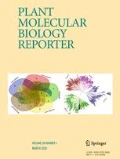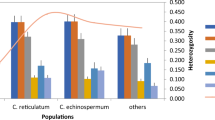Abstract
Many molecular marker techniques are available today. PCR-based approaches are in demand because of their simplicity and requirement for only small quantities of sample DNA. Nonanchored inter simple sequence repeats (ISSRs) are arbitrary multiloci markers produced by PCR amplification with a microsatellite primer. They are advantageous because no prior genomic information is required for their use. We found the technique stable across a wide range of PCR parameters. Polymorphisms were abundant among 7 dicot species tested with 2 tri-nucleotide and 2 tetra-nucleotide primers. Thus, nonanchored ISSR markers are a good choice for DNA fingerprinting.
Similar content being viewed by others
Abbreviations
- AFLPs:
-
amplified fragment length polymorphisms
- CTAB:
-
cetyltrimethylammonium bromide
- ISSR:
-
inter simple sequence repeat
- MP-PCR:
-
microsatellite-primed PCR
- PCR:
-
polymerase chain reaction
- RAPD:
-
random amplified polymorphic DNA
- SSRs:
-
simple sequence repeats
References
Gupta PK and Varshney RK (2000) The development and use of microsatellite markers for genetic analysis and plant breeding with emphasis on bread wheat. Euphytica 113: 163–185.
Hansen M, Halldén C and Säll T (1998) Error rates and polymorphism frequencies for three RAPD protocols. Plant Mol Biol Rep 16: 139–146.
Joens CJ, Edwards KJ, Castaglione S, Winfield MO, Sale F, Van de Wiel C, Bredemeijer G, Buiatti M, Maestri E, Malcevshi A, Marmiroli N, Aert R, Volckaert G, Rueda J, Linacero R, Vazquez A and Karp A (1997) Reproducibility testing of RAPD, AFLP and SSR markers in plants by a network of European laboratories. Mol Breed 3: 381–390.
Karp A, Kresovich S, Bhat KV, Ayada WG and Hodgkin T (1997) Molecular tools in plant genetic resources conservation: a guide to the technologies. IPGRI technical bulletin no 2. International Plant Genetic Resources Institute, Rome, Italy.
Meyer W, Michell TG, Freedman EZ and Vilgalys R (1993) Hybridization probes for conventional DNA fingerprinting used as single primers in polymerase chain reaction to distinguish strain ofCryptococcus neoformans. J Clin Biol 31: 2274–2280.
Nagaoka T and Ogihara Y (1997) Applicability of inter-simple sequence repeat polymorphisms in wheat for use as DNA markers in comparison to RFLP and RAPD markers. Theor Appl Genet 94: 597–602.
Poulsen GB, Kahl G and Weising K (1994) Differential abundance of simple repetitive sequences in species ofBrassica and relatedBrassicaceae. Plant Syst, Evol 190: 21–30.
Sanchez de la Hoz MP, Dàvila JA, Loarce Y and Ferrer E (1996) Simple sequence repeat primers used in polymerase chain reaction amplifications to study genetic diversity in barley. Genome 39: 112–117.
Sharma PC, Huttel B, Winter P, Kahl G, Gardner RC and Weising K (1995) The potential of microsatellites for hybridization and polymerase chain reaction-based DNA fingerprinting of chickpea (Cicer arietium L.) and related species. Electrophoresis 16: 1755–1761.
Tautz D (1989) Hypervariability of simple sequences as a general source for polymorphic DNA markers. Nucleic Acids Res 17(16): 6463–6471.
Tsumura Y, Ohba K and Strauss SH (1996) Diversity and inheritance of inter-simple sequence repeat polymorphisms in Douglas-fir (Pseudotsuga menziesii) and sugi (Cryptomeria japonica). Theor Appl Genet 92: 40–45.
Virk PS, Zhu J, Newbury HJ, Bryan GJ, Jackson MT and Ford-Lloyd BV (2000) Effectiveness of different classes of molecular markers for classifying and revealing variations in rice (Oryza sativa) germplasm. Euphytica 112: 275–284.
Vos P, Hogers R, Bleeker M, Reijans M, Van der Lee T, Hornes M, Frijters A, Pot J, Peleman J, Kuiper M and Zabeau M (1995) AFLP: a new technique for DNA fingerprinting. Nucleic Acids Res 23: 4407–4414.
Williams JGK, Kubelik AR, Livak KJ, Rafalski JA and Tingey SV (1990) DNA polymorphisms amplified by arbitrary primers are useful as genetic markers. Nucleic Acids Res 18: 6231–6235.
Zietkiewicz E, Rafalski A and Labuda D (1994) Genome fingerprinting by simple sequence repeat (SSR)-anchored polymerase chain reaction amplification. Genomics 20: 176–183.
Author information
Authors and Affiliations
Corresponding author
Rights and permissions
About this article
Cite this article
Bornet, B., Branchard, M. Nonanchored Inter Simple Sequence Repeat (ISSR) markers: Reproducible and specific tools for genome fingerprinting. Plant Mol Biol Rep 19, 209–215 (2001). https://doi.org/10.1007/BF02772892
Published:
Issue Date:
DOI: https://doi.org/10.1007/BF02772892




